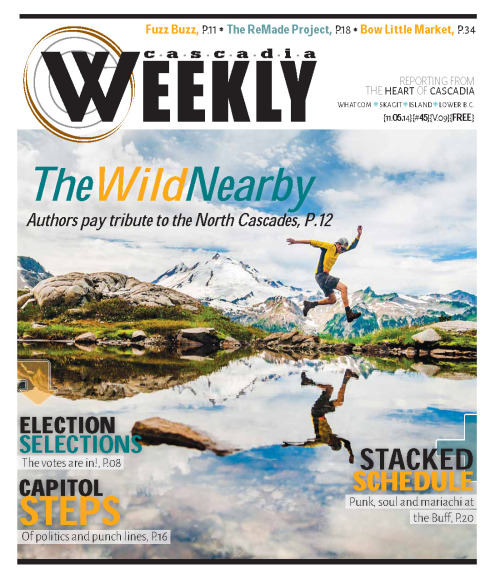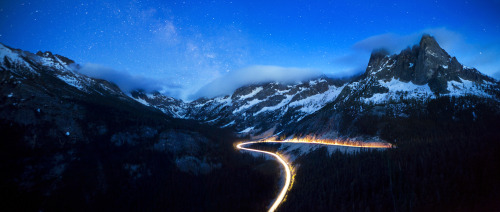The North Cascades: Finding Beauty and Renewal in the Wild Nearby

Editor’s note: The following essay is an excerpt from the new book The North Cascades: Finding Beauty and Renewal in the Wild Nearby, published this fall by Braided River, a conservation imprint of the Mountaineers Books. Please join North Cascades Institute at one of our book launch celebrations in Mount Vernon or Bellingham this week (with related presentations happening in Twisp, Darrington and Seattle) — details at www.ncascades.org/wildnearby. Read a review of the book in the Everett Herald here and the Skagit Valley Herald here.
By William Dietrich
The North Cascades are surrounded by seven million people, crisscrossed by jetliners, and threaded by highways. Their retreating glaciers have become a barometer of climate change. At the same time, grizzly, wolf, wolverine, and eagle, once shot and trapped, are coming back. There is a new Environmental Learning Center across Diablo Dam, and new philosophies about forest fires, ecosystem management, and outdoor recreation. The North Cascades are exactly the same, and completely different.

Life in the Pacific Northwest has accelerated. Microsoft and Amazon have supplanted resource-based companies such as Weyerhaeuser as economic drivers. Computers have globalized us. We’ve all become minutemen, with once-a-day mail delivery giving way to minute-by-minute email, Facebook posts, and Twitter feeds. An entire vocabulary of technical jargon has been mastered, society has become more diverse, and newcomers have injected their own take, deciding to call Puget Sound “the” Puget Sound, out of our inexplicable drive to complicate everything. Manual labor has given way to sedentary jobs, and in response camping and backpacking equipment has gone high-tech and recreational choices have exploded. We’re connected, busy, isolated, worldly, and stressed. Accordingly, the North Cascades represent escape and self-fulfillment. They beckon as last-stand glory, temple, and playground.

There is the reality of the mountains, that difficult terrain wracked by evolving change. “It is incredibly wild,” says Chip Jenkins, a former North Cascades National Park superintendent now serving as deputy regional director. “It is raw. It is physically and psychologically demanding.” And there is the ideal of the mountains, a place frozen into a calendar photo. The North Cascades are besieged and yet sacrosanct. They are eternal, and yet their purpose is constantly being reinvented in our minds.
Tucked into the fourth corner of the United States, these mountains were the last to be explored. They are still remote, jungle-dense on their western slopes, and relatively unknown. Fjord-narrow lakes wind into the mountain fastness; it is a fifty-five-mile boat trip from Chelan to the mountain hamlet of Stehekin in Lake Chelan National Recreation Area, at the southeastern edge of North Cascades National Park. The North Cascades Highway, opened in 1972, brings three-quarters of a million people through a corridor between the two halves of that park each summer season, but only twenty-six thousand walk far enough from their cars to enter the park proper. Gettysburg Battlefield gets more visitors in a busy weekend than the halfmillion- acre park gets in a year. It is deliberately roadless. You have to seek it.

The park is also truncated. Because of political compromise, Mount Baker is outside the national park “complex” (which technically includes the park lands and adjacent national recreation areas). So is the other glaciated volcano in the range, Glacier Peak. There is a bewildering patchwork of land designations, a contentiously debated road network, and a consortium of agencies.
Which brings us to peril. Visionaries protected this range over many decades of political battle in the twentieth century. What one sees today from the summit of Mount Baker—craggy Mount Shuksan, the fanged Picket Range, the ice cream mound of Glacier—now needs a new generation of stewardship. How shall we manage these crags? Can their complex succession of ecosystems be sustained? Will salmon survive in the rivers? Will grizzlies, wolves, and wolverines roam? How can the North Cascades be resilient in the face of climate change? Since 1915, average air temperatures at Diablo Dam on the Skagit River have risen about 1 degree Fahrenheit, global warming shrinking the average snowpack. Can an alpine environment thrive if adjacent lowlands are paved over? Can we help native plants and organisms resist invasive species? How can a growing and aging urban population visit this landscape without overpowering it? What does wilderness mean when it abuts a megalopolis of thickening development that stretches from Vancouver, British Columbia, to Eugene, Oregon?

In a frenzied world, the North Cascades are a refuge of calm. In a warming world, they are a remnant of the Ice Age. In a homogenous world, they remain exotic. In a crowded world, they are empty.
They are best befriended on foot.
Excerpted from The North Cascades: Finding Beauty and Renewal in the Wild Nearby (Braided River, an imprint of Mountaineers Books, Sept. 2014). Mountains photo by Steph Abegg; climber, night photos and tree by Ethan Welty.

